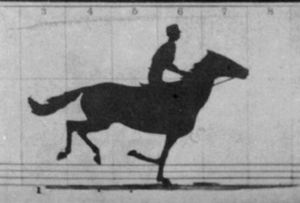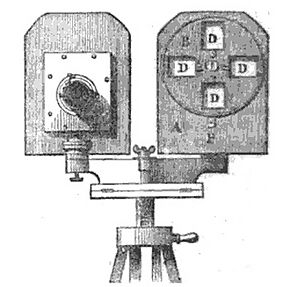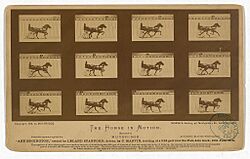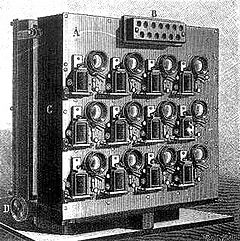Chronophotography facts for kids
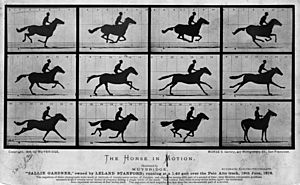
Chronophotography is an old photography method from the Victorian era. It captures many different moments of something moving. Most famous chronophotography was used to study how animals move. This helped animal handlers and artists. Even though many of these pictures were not meant to be shown as movies, they were an important step towards making motion pictures.
Contents
What is Chronophotography?

Chronophotography means taking many photos of a moving object. The goal is to record and show each step of its movement. The word chronophotography was created by a French scientist named Étienne-Jules Marey. He used it to describe photos of movement that could be measured and studied. The word comes from the Greek word chrónos, which means "time," and photography.
How Chronophotography Developed
Early Ideas (1840s)
Photography started in 1839. Soon, cameras became the best way to show real life. As cameras got better, people found new ways to use them.
Around 1840, Francis Ronalds thought about using photos for science. In 1845, he built a machine to record weather changes on photo paper. These cameras were sent to many observatories around the world. Some were used for a long time.
Early photographers often took many pictures of one thing. This was to make sure they got a good shot. Also, old photos called Daguerreotypes could not be copied. So, taking many shots was a way to get multiple pictures. Some photographers used many cameras at once. This made a series of pictures taken at slightly different times or angles.
In 1844, Antoine Claudet showed off some "multiple portraits." These included a series of twelve self-portraits. They showed his face from one side to the other. He used a simple device that took many pictures quickly on one plate. Claudet thought these pictures were just interesting, not very useful. Later, André-Adolphe-Eugène Disdéri made similar devices popular for making cartes de visite.
Capturing Motion (1849-1870s)
When 3D photography became popular in the 1850s, people believed photos could create a perfect illusion of reality. Adding motion and color to photos seemed like the next step.
Early photo series that showed movement had to be taken one pose at a time. This was because cameras needed a long time to take a picture back then. The results were sometimes used in devices like the fantascope (from 1833) or the zoetrope (from 1866). These devices made the still photos look like they were moving.
In 1849, Joseph Plateau wrote about improving his fantascope. He talked about combining it with 3D photos. He thought of using stop motion to get the needed photo sequence. This idea was later given to Jules Duboscq. In 1852, Duboscq patented his "stéréoscope - fantascope or bioscope." He sold the device, but it was not very successful.
Muybridge, Marey, and Others (1878-1890s)
Cameras got better, and pictures could be taken in less than a second. This made real-time chronophotography possible.
In 1873, Leland Stanford, a horse lover, hired Eadweard Muybridge. He wanted Muybridge to take a quick photo of his horse running fast. Muybridge worked hard and finally took a blurry picture. It showed the horse's leg positions, which interested Stanford. Years later, Stanford wanted a series of photos to show all the positions of a running horse. Muybridge used many cameras along a track. Wires triggered the cameras as the horse ran past.
Muybridge's first chronophotography series was called The Horse in Motion. It came out in 1878. People around the world were amazed. The horse's poses looked different from how artists usually drew them.
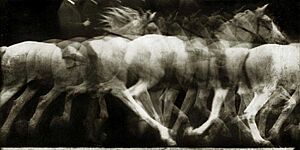
After seeing Muybridge's work, scientist Étienne-Jules Marey was not happy with the many-camera method. In 1882, he created the Chronophotographic gun. This was inspired by Jules Janssen's photographic revolver.
Albert Londe was a medical photographer. In 1882, he made a camera with nine lenses. It had a complex timing system to study how patients moved. Londe later improved this system. It could take twelve pictures in just a tenth of a second.
Georges Demeny, Marey's helper, found more ways to show movement. He made a simple projector called the stroboscope. He and German photographer Ottomar Anschutz worked together on projecting technology. They used chronophotographs and projectors to create movement, much like modern projections. Anschutz even used chronophotographs for entertainment. He also invented a camera with a "focal-plane shutter." This allowed photos to be taken at 1/1000 second exposures. This made Muybridge's system faster. Anschutz also made a personal viewer for his chronophotographs.
How Chronophotographs Were Made
To make chronophotographs, many cameras were set up. They photographed a moving subject as it went past. Wires or electric timers triggered each camera. The photographer then put together a series of twelve photos. These photos showed the subject moving. Subjects could be a running horse, a person walking down stairs, or objects being thrown.
To show different movements on one photo plate, like Marey and Demeny did, a photographer would use strips of film. Marey also made a device shaped like a gun. It took twelve quick photos of birds flying. The gun had two spinning discs. One disc had 12 openings, and the other had a slit. When the trigger was pulled, the discs spun. Each opening appeared behind the lens and was exposed through the slit. This created a layered effect. Later, Marey could take photos on film rolls and project them.
The finished chronophotographs could be put into different devices. These devices either showed the movement or helped compare the different stages of movement.
How Chronophotography Was Used
Chronophotography was first used to help scientists study moving things. This mostly included humans and animals. It was also used for practical things, like timing races or studying how things like bullets moved.
When Anschutz started making entertaining chronophotographs, this method became the basis for inventing and developing cinematography (movie making). New projection devices were created, like Muybridge's zoopraxiscope and Anschutz's electrotachyscope. These made showing chronophotographs for fun much better. Soon, movie devices came from these early chronophotography inventions. Audiences could then watch continuous loops of entertaining activities. These developments led to the invention of silent films and moving images.
A Romanian neurologist named Gheorghe Marinescu made a film in 1898. It was called Walking Troubles of Organic Hemiplegy. He was inspired by Marey's chronophotography. The short film shows patients walking in different directions before and after treatment. This film and others by Marinescu are considered early documentary films. He called his works "studies with the help of the cinematograph." He published his findings in a magazine between 1899 and 1902.
As photography became the main way to show life accurately, art changed. Artists no longer had to just capture life exactly as it was. They could now explore simultaneity. This meant showing several positions in space at different times in one painting. Cubist artworks often showed multiple angles in one picture. They also showed different aspects of time and motion. Examples include Jean Metzinger's Danseuse au café (Dancer in a Café) (1912). Marcel Duchamp's famous Nu descendant un escalier n° 2 (Nude Descending a Staircase, No. 2) (1912) was directly influenced by Muybridge's Woman Walking Downstairs (1887) and Marey's work.


